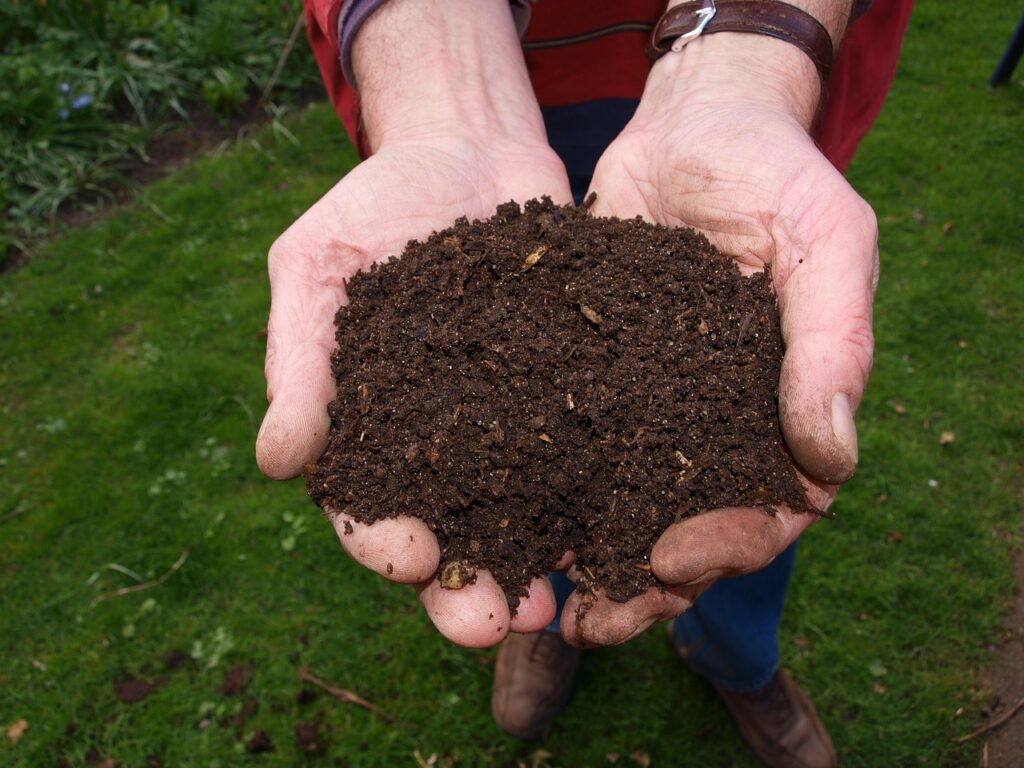Home>Gardening Basics>Why Is Fertilizer Used In Bombs


Gardening Basics
Why Is Fertilizer Used In Bombs
Modified: January 22, 2024
Understand the role of fertilizer in bombs and its application in soil. Learn about the significance of understanding soil composition for agricultural practices.
(Many of the links in this article redirect to a specific reviewed product. Your purchase of these products through affiliate links helps to generate commission for Chicagolandgardening.com, at no extra cost. Learn more)
Table of Contents
Introduction
Welcome to the fascinating world of soil! Soils serve as the foundation for life on Earth, providing nutrients and support for plants, habitats for microorganisms, and serving as a filter for water. Understanding soil composition, structure, and characteristics is essential for sustainable agriculture, environmental conservation, and land management.
Soil is a complex mixture of minerals, organic matter, water, and air, all working together to create a dynamic and living ecosystem beneath our feet. From sandy soils to clay-rich soils, each soil type possesses unique properties and plays a vital role in determining what can grow and thrive on its surface.
In this article, we will explore the intricacies of soil and delve into the factors that influence soil formation, composition, and fertility. We will also discuss how soil classifications are determined and how they impact agricultural practices and land use decisions.
Throughout history, societies have recognized the importance of soil and its connection to food production. Ancient civilizations developed agricultural techniques to optimize soil fertility and maximize crop yield. Today, modern agricultural practices, including the use of fertilizers, aim to increase soil productivity and ensure food security for a rapidly growing global population.
Furthermore, soil serves as a vital carbon sink, playing a crucial role in mitigating climate change. Soil organic matter, formed by decaying plants and microorganisms, acts as a reservoir for carbon. By adopting sustainable land management practices, we can enhance soil health and promote carbon sequestration, aiding in the fight against global warming.
So join us as we explore the intricate world of soil and uncover its secrets. By the end, you will gain a deeper appreciation for the invaluable role that soil plays in sustaining life and the importance of responsible soil stewardship for a healthier planet.
History of Fertilizer Bombs
The use of fertilizer bombs traces back to the early 20th century when individuals began experimenting with combining common fertilizers with other explosive materials. Fertilizer, which is typically composed of nitrogen, phosphorus, and potassium, provided a readily available source of chemicals that, when combined with certain substances, could create powerful and destructive explosions.
One of the most significant instances of fertilizer bombs being used was the 1995 Oklahoma City bombing. In this tragic incident, Timothy McVeigh utilized ammonium nitrate fertilizer mixed with other chemicals to construct a massive bomb that destroyed the Alfred P. Murrah Federal Building, claiming the lives of 168 people.
Prior to this event, fertilizer bombs were relatively uncommon. However, the Oklahoma City bombing put a spotlight on the potential dangers and destructive capabilities of these improvised explosive devices (IEDs). The incident prompted governments and security agencies around the world to reassess their protocols and regulations concerning the sale, distribution, and use of fertilizers.
Following the Oklahoma City bombing, increased attention was given to the control and tracking of fertilizer sales. Governments enacted legislation to restrict the purchase and storage of certain types and quantities of fertilizers, particularly those containing ammonium nitrate, which is a key ingredient in many fertilizer bombs.
Despite these measures, fertilizer bombs continue to be a concern in terms of their potential use in acts of terrorism and violence. The relative ease of acquiring and handling fertilizers, combined with the knowledge widely available on the internet, has increased the risk of individuals attempting to create homemade explosives using fertilizers.
In recent years, various incidents and thwarted plots involving fertilizer bombs have further highlighted the need for enhanced security measures and vigilance. Law enforcement agencies, intelligence organizations, and agricultural suppliers have collaborated to develop strategies and protocols aimed at preventing the misuse of fertilizers.
It is essential to acknowledge that fertilizers themselves are not inherently dangerous or harmful. They play a crucial role in agriculture, boosting crop production and ensuring food security. The challenge lies in striking a balance between enabling legitimate agricultural practices and preventing the misuse of fertilizers for illicit purposes.
As we delve deeper into the components and explosive capabilities of fertilizers used in bombs, it becomes evident that understanding the history and context of their development is crucial in formulating effective security measures to combat their misuse.
Components of Fertilizers Used in Bombs
The components of fertilizers typically used in bombs consist of nitrogen-rich compounds, such as ammonium nitrate, which is the most commonly used ingredient. Ammonium nitrate is a white crystalline substance that contains both nitrogen and oxygen, making it an excellent source of oxidizer for explosive reactions.
In addition to ammonium nitrate, other substances commonly found in fertilizer bomb recipes include fuel oil or diesel, which serve as the combustible element. This combination of an oxidizer (ammonium nitrate) and a fuel source (such as fuel oil) creates a potent explosive mixture known as ANFO (Ammonium Nitrate Fuel Oil).
ANFO explosives are widely used due to their relative ease of preparation and high stability. The combination of ammonium nitrate and fuel oil creates a powerful explosion when ignited, as the fuel rapidly combines with the oxygen released from the ammonium nitrate, resulting in a violent release of energy.
It is important to note that not all fertilizers contain the necessary components for bomb-making. The focus is primarily on fertilizers containing ammonium nitrate, as this compound has the ideal properties for explosive reactions.
Ammonium nitrate is readily available and widely used in the agricultural industry as a nitrogen fertilizer. Its use in bomb-making, therefore, raises concerns about its accessibility and potential for misuse. Regulations have been implemented in many countries to monitor and control the sale and distribution of fertilizers containing ammonium nitrate to prevent their unauthorized use in bomb-making.
Other potentially explosive compounds that have been used in fertilizer bombs include urea nitrate and ammonium sulfate, both of which possess the necessary chemical properties for explosive reactions when combined with other substances.
It is important to note that the components used in fertilizer bombs are not exclusive to fertilizers. They can often be found in other industrial chemicals or easily acquired through legal means. However, the use of fertilizers as a readily available and easily accessible source of these components has raised concerns and led to stricter regulations and monitoring.
Understanding the components of fertilizers used in bombs is crucial for developing effective countermeasures and ensuring the responsible use of these materials. By focusing on preventing access to and monitoring the sale of fertilizers containing these potentially explosive compounds, authorities can mitigate the risk of fertilizer bomb attacks while still allowing legitimate agricultural practices to continue.
How Fertilizers Enhance Explosive Power
The use of fertilizers in bombs enhances the explosive power due to the specific chemical properties of the compounds they contain, such as ammonium nitrate. When combined with other substances, fertilizers can create a highly volatile mixture capable of generating devastating explosions.
One of the main reasons fertilizers are effective in enhancing explosive power is their high nitrogen content. Nitrogen serves as an essential component in the combustion process by providing a readily available source of oxidizer. When a fertilizer containing ammonium nitrate is ignited, it releases oxygen that rapidly reacts with a fuel source, such as fuel oil or diesel, resulting in a significant release of energy.
The release of energy in an explosion depends on the speed and efficiency of the combustion process. Fertilizers, with their specific chemical composition, offer several advantages in this regard. Ammonium nitrate, for example, is highly reactive and easily decomposes when exposed to heat or a spark. This quick decomposition leads to the rapid release of gases, increasing the pressure and energy in the explosion.
Furthermore, fertilizers have the ability to sustain the combustion process over an extended period. The fuel component, whether it is fuel oil or another combustible material, serves as a sustaining agent, ensuring a continuous supply of fuel for the oxidation reaction. This sustained combustion contributes to a more powerful explosion compared to explosives that burn out quickly.
The physical properties of fertilizers also play a role in enhancing explosive power. The solid nature of fertilizer compounds, particularly ammonium nitrate, allows for easy mixing with fuel sources, creating a homogeneous explosive mixture. This uniform distribution of components contributes to a more efficient combustion process and a more uniform release of energy.
Moreover, the widespread availability and easy accessibility of fertilizers make them attractive choices for those seeking to create homemade explosive devices. Their use in bomb-making is further facilitated by the relatively simple preparation methods and the accessibility of instructional resources online.
It is important to note that the enhanced explosive power of fertilizers also presents significant risks and dangers. Their misuse for malicious purposes, such as in acts of terrorism, highlights the need for strict regulations and control measures to prevent their unauthorized acquisition or use. Governments and security agencies continually monitor and adapt strategies to mitigate these risks and ensure the responsible handling and distribution of fertilizers.
Understanding how fertilizers enhance explosive power is vital for developing effective countermeasures and strengthening security protocols. By comprehending the factors that contribute to their explosive capabilities, authorities can enact regulations that strike a balance between supporting legitimate agricultural practices and safeguarding against potential misuse.
Examples of Fertilizer Bombs
Over the years, there have been several instances where fertilizer bombs have been used for malicious purposes, resulting in devastating consequences. These examples highlight the destructive power and potential danger associated with improvised explosive devices (IEDs) made from readily available fertilizers.
One of the most notorious examples is the 1995 Oklahoma City bombing, where Timothy McVeigh used a large quantity of ammonium nitrate fertilizer mixed with other chemicals to construct a powerful bomb. The explosion destroyed the Alfred P. Murrah Federal Building, claiming the lives of 168 people and causing extensive damage to surrounding structures.
Another example is the 2002 Bali bombings, where attackers utilized a combination of ammonium nitrate fertilizer and other substances to create explosive devices. These bombs were strategically placed in crowded areas, resulting in a high number of casualties and extensive destruction.
In 2011, a fertilizer bomb was used in a terrorist attack in Oslo, Norway. The attacker, Anders Behring Breivik, detonated a large vehicle bomb in front of government buildings, causing multiple casualties and significant damage. Ammonium nitrate was again the primary component used in the creation of the explosive device.
These high-profile incidents have prompted governments and security agencies worldwide to reevaluate their protocols and regulations surrounding the sale, distribution, and monitoring of fertilizers. Stricter controls have been implemented to restrict access to and track the purchase of fertilizers that contain potentially explosive compounds like ammonium nitrate.
It is essential to recognize that these examples represent only a fraction of the instances where fertilizer bombs have been used. Numerous thwarted plots and incidents have been uncovered, emphasizing the ongoing threat posed by individuals seeking to exploit the explosive properties of fertilizers for malicious purposes.
Security agencies and experts continuously work to stay ahead of these threats by monitoring suspicious activities, enhancing intelligence efforts, and sharing information with domestic and international partners. This collaboration helps prevent and disrupt potential acts of terrorism involving fertilizer bombs.
Efforts are also being made to raise public awareness about the potential dangers associated with the misuse of fertilizers. This includes educating agricultural suppliers and retailers about warning signs and unusual purchasing patterns, as well as encouraging individuals to report suspicious activities to the authorities.
By understanding the examples of fertilizer bombs and the damage they have caused, governments, security agencies, and the public can remain vigilant and work together to mitigate the risks associated with these improvised explosive devices.
Security Measures and Restrictions on Fertilizer Sales
In response to the use of fertilizers in bomb-making, governments around the world have implemented various security measures and restrictions to curb the unauthorized acquisition and misuse of these potentially dangerous substances.
One of the primary approaches taken involves tightening regulations on the sale and distribution of fertilizers containing potentially explosive compounds, such as ammonium nitrate. Governments have implemented stricter controls to monitor and track the purchase of these fertilizers, aiming to identify and prevent suspicious or unauthorized transactions.
These regulations often require suppliers and retailers to maintain detailed records of fertilizer sales, including the quantity, date, and purchaser’s information. Authorities can request access to these records to investigate any suspicious activities or potential connections to illicit uses of fertilizers.
To enhance security and safety, governments have also mandated training and licensing programs for individuals engaged in the sale, handling, or transportation of fertilizers. These programs ensure that personnel possess the necessary knowledge and skills to identify potential red flags and adhere to strict security protocols.
Additionally, authorities have established collaboration and information sharing mechanisms between law enforcement agencies, intelligence organizations, and agricultural suppliers. This allows for timely sharing of information about suspicious activities, patterns, or individuals involved in potential fertilizer bomb-related activities.
Public awareness campaigns play a crucial role in supporting security measures. Agricultural suppliers and retailers are provided with resources and training to help them recognize signs of suspicious behavior, unusual purchasing patterns, or attempts to acquire large quantities of fertilizers without a legitimate agricultural purpose.
The use of technology, such as online platforms and databases, has also proven effective in monitoring fertilizer sales and facilitating information sharing between stakeholders. Electronic records and reporting systems contribute to efficient tracking and investigation of suspicious activities, enabling authorities to respond swiftly and effectively.
It is important to strike a balance between implementing security measures and enabling legitimate agricultural practices. Recognizing this, some governments provide exemptions or allowances for licensed farmers and agricultural operators who require fertilizers for legitimate purposes. This ensures that agricultural productivity and food security are not unduly compromised while mitigating the risks associated with fertilizer misuse.
Over time, security measures and restrictions on fertilizer sales continue to evolve as authorities identify new threats, adapt to emerging technologies, and learn from past incidents. By remaining vigilant and responsive, governments and security agencies can minimize the potential for fertilizer misuse while still supporting legitimate agricultural practices.
Risks and Dangers Associated with Fertilizer Bombs
The use of fertilizer bombs poses significant risks and dangers, both in terms of physical destruction and the potential loss of human lives. Understanding these risks is crucial for developing effective countermeasures and mitigating the threat posed by these improvised explosive devices.
One of the primary risks associated with fertilizer bombs is their destructive power. The combination of ammonium nitrate or other explosive compounds found in fertilizers with a fuel source creates a powerful explosive mixture. This can result in large-scale destruction of buildings, infrastructure, and surrounding areas, causing extensive financial losses and disrupting communities.
Fertilizer bombs also pose a significant risk to public safety. The casualties resulting from past incidents, such as the Oklahoma City bombing, demonstrate the potential for loss of human lives. The indiscriminate nature of these attacks, often targeting crowded areas or key infrastructure, increases the likelihood of multiple casualties and injuries.
Furthermore, the relative ease of acquiring fertilizer ingredients and the accessibility of bomb-making instructions online contribute to the risk of individuals or groups with malicious intent attempting to construct homemade explosive devices. The widespread availability of fertilizers makes it challenging to track potential misuses, highlighting the need for effective monitoring systems and strict control measures.
There is also a risk of copycat attacks and the spread of knowledge about fertilizer bomb-making techniques. Past incidents have shown that high-profile attacks using these devices can inspire and motivate others with similar intentions. Thus, maintaining up-to-date intelligence, enhancing security measures, and providing proper training to law enforcement agencies becomes critical in preventing future incidents.
Additionally, the environmental and health risks associated with fertilizer bombs should not be overlooked. The detonation of large quantities of fertilizers releases toxic gases and air pollutants, posing risks to both human and environmental health. The improper handling, storage, or disposal of these materials can result in soil and water contamination, impacting ecosystems and agricultural lands.
To address these risks, governments and security agencies have implemented various measures, including increased regulation, monitoring, and tracking of fertilizer sales. Strict control measures aim to prevent unauthorized access and misuse of these potentially dangerous substances. Additionally, public awareness campaigns educate individuals about the potential dangers associated with fertilizer bombs, encouraging them to report any suspicious activities to the authorities.
By understanding the risks and dangers associated with fertilizer bombs, authorities, law enforcement agencies, and the public can work together to enhance security measures, prevent potential attacks, and minimize the impact of any future incidents.
Conclusion
Understanding the intricacies of soil is essential for sustainable agriculture, environmental conservation, and land management. Soils serve as the foundation for life on Earth, providing vital nutrients and support for plants, habitats for microorganisms, and playing a crucial role in water filtration.
Throughout history, societies have recognized the importance of optimizing soil fertility to maximize crop yield and ensure food security. Modern agricultural practices, including the use of fertilizers, aim to enhance soil productivity and meet the growing demand for food.
While fertilizers play a crucial role in agricultural practices, it is important to be aware of their potential misuse as components of homemade explosive devices. Fertilizer bombs, made using substances such as ammonium nitrate, have been responsible for devastating incidents, including the Oklahoma City bombing.
To mitigate the risks associated with fertilizer bombs, governments have implemented security measures and restrictions on fertilizer sales. These measures include enhanced regulations, monitoring systems, licensing programs, and collaboration between stakeholders to prevent unauthorized acquisition and misuse of these potentially dangerous substances.
Despite the risks, it is crucial to recognize that fertilizers themselves are not inherently harmful. They play a vital role in supporting agriculture and ensuring food security. Responsible use and adherence to regulations are key in striking a balance between enabling legitimate agricultural practices and preventing fertilizer bomb-related incidents.
Continued efforts in public awareness, training, and technological advancements will further strengthen security measures and minimize risks associated with fertilizer bombs. By staying vigilant, sharing information, and working together, governments, security agencies, and the public can mitigate the threats posed by these improvised explosive devices.
Ultimately, gaining a deeper understanding of soil, its properties, and its potential applications contributes to responsible land management and environmental sustainability. By appreciating the complexities of soil and the role it plays in nurturing life, we can strive for a healthier planet, a more secure society, and a sustainable future for generations to come.










